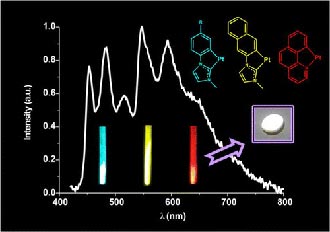|
We report on the generation of bright white luminescence through solid-state illumination of remote phosphors based on novel cycloplatinated N-heterocyclic carbene (NHC) compounds. Following a stepwise protocol we got the new NHC compound [{Pt(μ-Cl)(C^C*)}2] (4) (HC^C*-κC* = 1-(4-(ethoxycarbonyl)phenyl)-3-methyl-1H-imidazol-2-ylidene), which was used together with the related ones 4a (HC^C*-κC*= 1-(4-cyanophenyl)-3-methyl-1H-imidazol-2-ylidene) and 4b (HC^C*-κC*= 3-methyl-1-(naphthalen-2-yl)-1H-imidazol-2-ylidene) as starting materials for the synthesis of the new ionic derivatives [Pt(R-C^C*) (CNR')2]PF6 (R = -COOEt, R' = t-Bu (5), Xyl (6); R = -CN, R' = t-Bu (7), Xyl (8); R^C = Naph, R' = t-Bu (9), Xyl (10)). The X-ray structures of 6 and 8-10 have been determined. The photophysical properties of these cationic compounds have been studied and supported by the time-dependent-density functional theory (TD-DFT) calculations. The compounds 5, 8, and 9 have been revealed as the most efficient emitters in the solid state with quantum yields of 41%, 21%, and 40%, respectively. White-light remote-phosphors have been prepared just by stacking different combinations of these compounds and [Pt(bzq) (CN) (CNtBu)] (R1) as blue (5, 8), yellow (9), and red (R1) components onto the same substrate. The CCT (correlated color temperature) and the CRI (color rendering index) of the emitted white-light have been tuned by accurately controlling the individual contributions.
|

